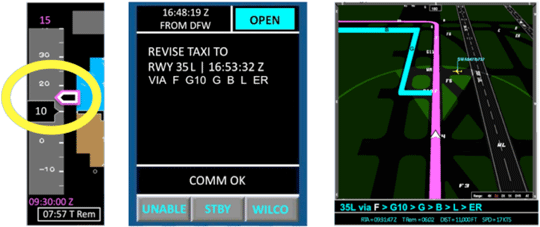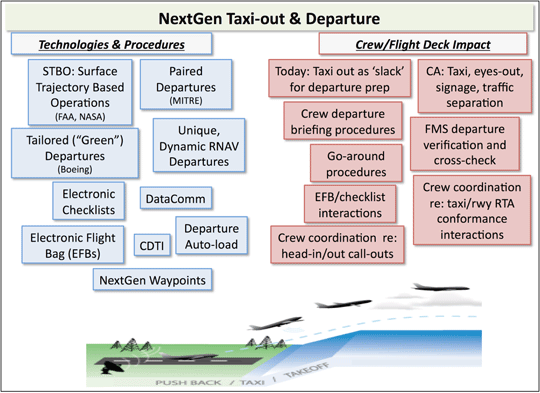As NextGen surface trajectory-based operations (STBO) are developed, This research program has developed and evaluated a flight deck “error-nulling” display/algorithm that allows pilots to comply accurately with STBO RTAs. Further research has investigated the interaction of NextGen STBO tasks on NextGen departure task requirements.
What will NextGen Surface Operations Look Like?
NextGen Surface operations are one aspect of the design of the next generation (NextGen; JPDO, 2009) of the National Airspace System. Research efforts for this phase of flight have focused on the development of surface traffic management (STM) systems for air traffic control (ATC) to provide taxi clearances enabling efficient airport operations and improved throughput while reducing delays and environmental impacts associated with lengthy departure queues. Towards these goals, it is expected that future STM systems will have associated aircraft arrival times (i.e., required time of arrival, RTA) at active runway thresholds so that aircraft can cross with minimal or no delay, and at the departure runway, enabling aircraft departure queue sequencing. Such future “full capability” STM systems will require aircraft to reach specified locations on the airport surface with relatively precise timing. These NextGen taxi operations with “taxi clearances and RTAs” are termed surface trajectory-based operations (STBO).
What does NextGen Surface Operations Mean for Pilots?
In order to achieve an RTA at a runway crossing or departure runway, pilots will be provide information such as a recommended aircraft speed required to reach the specified location at the specified time, and departure sequence information, This additional information on the flight deck, coupled with requirements for more precise aircraft control and the need to monitor speed and/or required time of arrival (RTA) performance may place additional demands on the flight crew, on what is already commonly regard as the phase of flight with the highest workload (Newman, 2008 as cited in Foyle et al, 2009).
How will our research make NextGen Surface Operations Safer and more Efficient?
Our research is aimed at the development and certification of these NextGen flight deck technologies to ensure that they do not draw the pilots’ eyes into the cockpit at the expense of maintaining awareness of the external airport and traffic environment and to ensure that the requirements for more precise aircraft control and the need to monitor speed and/or required time of arrival (RTA) performance will not place excessive demands on the flight crew.
Our research has demonstrated the need for a flight deck technology solution to aid pilots in safely meeting the speed/time requirements of STBO. One technology solution investigated by Foyle et al. (2011, Expt. 4) was a speed indicator on the primary flight display (PFD) driven by an “error-nulling” algorithm (see Figure). The speed algorithm dynamically compensated for speed-maintenance deviations by adjusting the current advised speed according to the remaining time and current distance to the RTA location. In addition to improved RTA error, pilots reported that the use of the algorithm/display did not compromise their out-the-window attention.

How will NextGen Surface Operations Interact with Departure Operations?
Departure operations are traditionally under-represented in terms of R&D efforts. However, in order to accomplish many of the NextGen goals, research is required to increase the efficiency of departure operations. Some NextGen flight deck concepts under investigation add complexity to departure operations and require research to understand how to present these new complex clearances to the pilots and how they impact pilot procedures and operations including departure briefings and clearance error-checking and verification. The interaction between taxi-out and departure operations is particularly vulnerable to conflict because much of the preparation for departure including receiving a departure clearance, verifying and cross-checking the departure clearance, crew briefings, and managing clearance modifications all occur during taxi-out (See Figure). As such, these NextGen concepts cannot be considered in isolation, rather they must be developed and evaluated in parallel. For example, currently the pilot taxiing can adjust taxi speed to ensure that the flight crew has completed the departure clearance verification and departure briefing by the time they arrive at the departure runway for takeoff -- in a sense, taxi-out “takes up the slack” for departure preparations. However, NextGen operations could create a dangerous requirement on pilots by simultaneously increasing the complexity and time required to brief dynamic RNAV departures and requiring that they do so while meeting a very precise Required Time of Arrival (RTA) at the departure runway (Foyle et al, 2009, 2011) which would enable further time-based metering of the departure stream into the enroute traffic stream (especially important for metroplex operations). Interactions such as these require extensive research to ensure a safe, seamless transition between taxi and departure operations for the flight crew.

Go to: NextGen Surface Operations and Terminal Area Integration Publications Available For Download
|